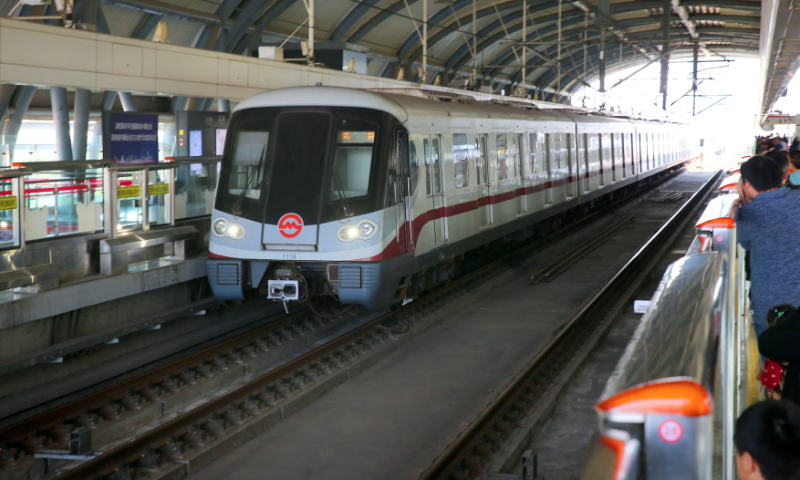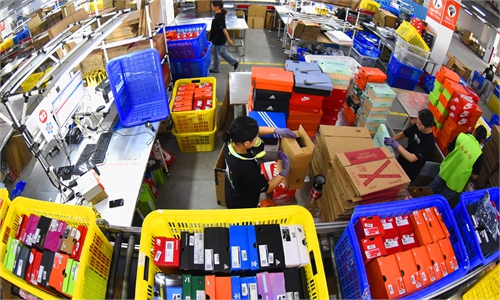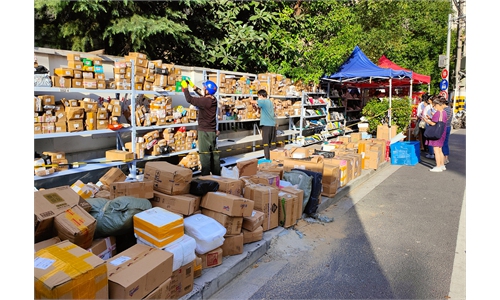
China's first trans-provincial subway line, Shanghai Metro Line 11, linking the country's commercial hub of Shanghai with Kunshan city in neighboring Jiangsu Province Photo: IC
A number of cities in East China's Jiangsu Province have resumed daily commute to and from Shanghai and eased quarantine measures for travelers from the neighboring megacity, in the latest efforts to resume normal traffic in the Yangtze River Delta region as Shanghai rises from the shadow of a stormy Omicron wave.
Daily commutes to Shanghai will resume in an orderly manner starting Monday for people who have fixed residence or workplace in Kunshan, Jiangsu Province, the local epidemic prevention and control authority announced on Sunday.
This move signals the progressive resumption of normal traffic in the Yangtze River Delta region and an important step to further speed up the restoration of normal production and life while striking a balance between epidemic prevention and control with economic and social development in the Yangtze River Delta region.
According to a statement released by the Kunshan epidemic prevention and control headquarters, commuters can travel between the two cities with electronic passes obtained by registering their personal information in a mobile app, a letter of commitment and negative results for nucleic acid testing obtained within 24 hours.
Kunshan, as other cities around Shanghai, is home to a slew of manufacturing companies in the Yangtze River Delta region which serves a vital role in the national economic development.
In particular, the convenience of public transportation between Shanghai and Kunshan draws the two cities closer. The Huaqiao Station of Shanghai's Metro Line 11 is situated in Kunshan. The station will also serve as a transfer hub when the Suzhou Rail Transit Line S1 is complete.
Many people commute by metro between the two cities since they live in one place but work in the other.
The statement from the Kunshan authority also noted that commuters have to travel in a closed-loop trip between their companies and their residences. They shall not go to medium- or high-risk areas or participate in any gathering activities. People they cohabit with or work with also have to comply with the regulations on nucleic acid testing.
Wuxi in Jiangsu also issued a similar regulation that allows daily commuters with green health codes or records of nucleic acid tests to travel between Wuxi and Shanghai.
Besides the reopening of daily commute, a number of cities in Jiangsu Province, including its capital Nanjing, Suzhou, Wuxi, and Changzhou have relaxed quarantine measures for people coming from Shanghai.
For those coming from medium- and high-risk regions in Shanghai, they are required to stay in centralized quarantine for seven days and another week at home, while people from other places in Shanghai will only have to stay at home for seven days for health monitoring.
The definition of health monitoring differs from city to city. In Nanjing, the policy means that people can still go out in accordance with epidemic prevention rules, only advising them not to go to crowded places. Meanwhile, in Changzhou, the health monitoring status means no access to public transportation or public venues. In Lianyungang of Jiangsu, censors will be placed on the front door if the household is under home monitoring.
Suzhou also lifted its restrictions for commuters from low-risk areas in Shanghai with no quarantine requirements. They will only need to track their health status and take nucleic acid tests four times in the first seven days of their arrival.
Hefei, capital of East China's Anhui Province in the Yangtze River Delta region, also loosened its restrictions on commuters from low-risk areas on Sunday.
According to the city's official WeChat account, the city will set two different channels for people from low-risk areas and people from medium- and high-risk areas or other epidemic-related areas at each checkpoint around the city.
People from low-risk areas can pass the checkpoints without presenting negative results for nucleic acid tests obtained within 48 hours. Neither will they be required to take a nucleic acid test.
People from high-risk areas and other epidemic-related areas will continue to take nucleic acid tests for free and go through health monitoring.
Production and business activities were severely affected after the suspension of transportation and logistics between Shanghai and its neighboring cities due to the lockdown during the Omicron outbreak.
The loosening of the commuting ban between Shanghai and its neighboring cities shows the resumption of traffic in the region.
Global Times


